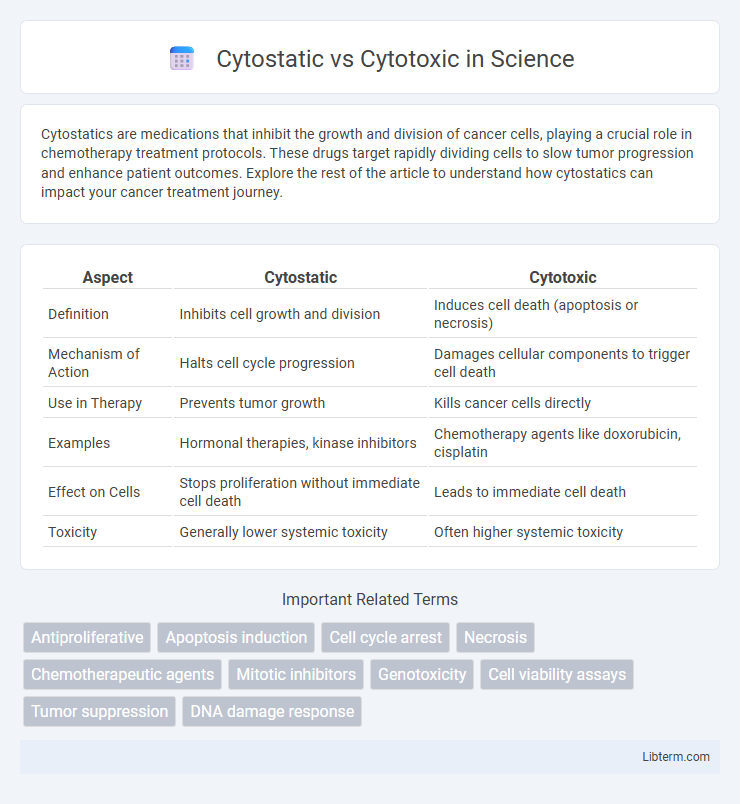Cytostatics are medications that inhibit the growth and division of cancer cells, playing a crucial role in chemotherapy treatment protocols. These drugs target rapidly dividing cells to slow tumor progression and enhance patient outcomes. Explore the rest of the article to understand how cytostatics can impact your cancer treatment journey.
Table of Comparison
| Aspect | Cytostatic | Cytotoxic |
|---|---|---|
| Definition | Inhibits cell growth and division | Induces cell death (apoptosis or necrosis) |
| Mechanism of Action | Halts cell cycle progression | Damages cellular components to trigger cell death |
| Use in Therapy | Prevents tumor growth | Kills cancer cells directly |
| Examples | Hormonal therapies, kinase inhibitors | Chemotherapy agents like doxorubicin, cisplatin |
| Effect on Cells | Stops proliferation without immediate cell death | Leads to immediate cell death |
| Toxicity | Generally lower systemic toxicity | Often higher systemic toxicity |
Understanding Cytostatic and Cytotoxic Agents
Cytostatic agents inhibit cell division by arresting the cell cycle, effectively preventing proliferation without directly causing cell death. Cytotoxic agents induce cell death through mechanisms such as apoptosis, necrosis, or autophagy, targeting rapidly dividing cancer cells. Understanding the distinct roles of these agents is crucial in optimizing cancer therapies, combining cytostatic drugs to control tumor growth and cytotoxic drugs to eliminate malignant cells.
Mechanisms of Action: Cytostatic vs Cytotoxic
Cytostatic agents inhibit cell proliferation by arresting the cell cycle, often targeting specific phases such as the G1 or S phase to prevent DNA replication and mitosis. Cytotoxic agents, in contrast, induce direct cell death through mechanisms like DNA damage, apoptosis, or necrosis, affecting both dividing and non-dividing cells. Understanding these mechanisms is crucial for selecting appropriate cancer therapies, as cytostatic drugs limit tumor growth while cytotoxic drugs reduce tumor mass by killing cancer cells.
Key Differences Between Cytostatic and Cytotoxic Drugs
Cytostatic drugs inhibit cell division by targeting the cell cycle, effectively halting tumor growth without directly killing cells, whereas cytotoxic drugs induce cell death through mechanisms like DNA damage or apoptosis. Cytostatic agents primarily arrest cells in specific phases, such as G1 or S phase, while cytotoxic agents cause irreversible cellular damage leading to necrosis or programmed cell death. Understanding these key differences is essential for tailoring cancer therapies to maximize efficacy and minimize side effects.
Clinical Applications and Usage
Cytostatic agents inhibit cell division by arresting the cell cycle, commonly utilized in cancer treatments to slow tumor progression without immediate cell death, making them suitable for long-term management of chronic malignancies. Cytotoxic drugs induce direct cellular damage leading to apoptosis, widely applied in aggressive chemotherapy protocols to rapidly reduce tumor burden in various cancers such as lymphoma and leukemia. Clinical application selection between cytostatic and cytotoxic agents depends on tumor type, progression rate, and patient tolerance, optimizing therapeutic outcomes by balancing efficacy and toxicity.
Advantages and Limitations of Cytostatic Therapy
Cytostatic therapy inhibits cancer cell proliferation by halting cell division, reducing tumor growth while minimizing damage to normal cells. This approach offers the advantage of lower toxicity and fewer side effects compared to cytotoxic treatments, making it suitable for long-term management of chronic cancers. However, cytostatic agents may be less effective in rapidly shrinking tumors and often require combination with other therapies to achieve optimal clinical outcomes.
Benefits and Risks of Cytotoxic Treatment
Cytotoxic treatments target rapidly dividing cancer cells by interfering with cell division, effectively reducing tumor size and progression. Benefits of cytotoxic therapy include its broad-spectrum efficacy against various malignancies and potential for combination with other treatments to enhance antitumor effects. Risks involve significant toxicity to healthy cells, leading to side effects such as immunosuppression, organ damage, and increased susceptibility to infections.
Side Effects and Toxicity Profiles
Cytostatic agents primarily inhibit cell proliferation by halting the cell cycle, often resulting in milder side effects such as fatigue, mild nausea, and reversible bone marrow suppression, whereas cytotoxic drugs induce direct cell death, leading to more severe toxicities including extensive myelosuppression, mucositis, and organ-specific toxicities like cardiotoxicity and nephrotoxicity. The toxicity profile of cytotoxic chemotherapy frequently necessitates rigorous monitoring of hematologic parameters and organ function to manage dose-limiting adverse effects. Cytostatic therapies generally exhibit a more targeted action with a comparatively favorable side effect profile, but long-term effects and resistance mechanisms remain clinical considerations.
Drug Resistance: Cytostatic vs Cytotoxic Agents
Cytostatic agents inhibit cell growth and proliferation by targeting specific cell cycle phases, often leading to reversible effects on tumor cells, whereas cytotoxic agents induce direct cell death through mechanisms like DNA damage or apoptosis. Drug resistance to cytostatic agents frequently involves alterations in cell cycle regulatory proteins or activation of alternative signaling pathways, while resistance to cytotoxic drugs is commonly linked to enhanced DNA repair, drug efflux pumps, or anti-apoptotic mechanisms. Understanding these distinct resistance pathways is crucial for designing combination therapies to overcome tumor cell survival during cancer treatment.
Choosing the Right Therapy: Patient Considerations
Choosing the right therapy between cytostatic and cytotoxic agents depends heavily on patient-specific factors such as tumor type, stage, and overall health. Cytostatic drugs, which halt cancer cell proliferation, are often preferred for patients requiring long-term disease management with reduced toxicity. In contrast, cytotoxic therapies are selected for aggressive cancers where rapid tumor reduction is critical, despite their higher side effect profiles and risks.
Future Directions in Cancer Therapy
Future cancer therapy is increasingly focusing on combining cytostatic agents, which inhibit tumor cell proliferation, with cytotoxic drugs that induce apoptosis, aiming to enhance treatment specificity and minimize side effects. Advances in targeted drug delivery, such as nanoparticle-based systems, are improving the therapeutic index of both cytostatic and cytotoxic compounds. Ongoing research in precision medicine is leveraging genomic and proteomic profiling to personalize these therapies, optimizing combinations for resistant and metastatic cancers.
Cytostatic Infographic

 libterm.com
libterm.com